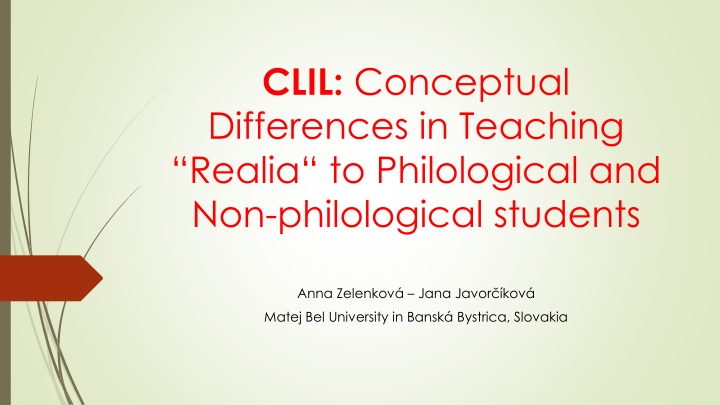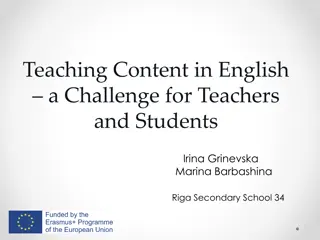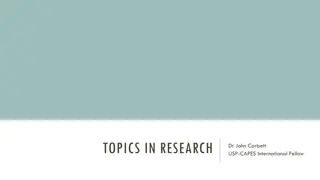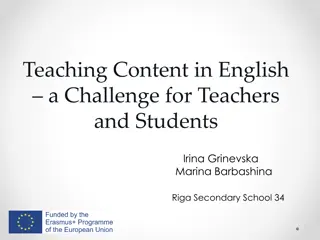
Teaching Realia in CLIL: Conceptual Differences and Solutions
Explore the conceptual differences in teaching realia to philological and non-philological students in Slovakia, focusing on the impact of CLIL methodology on language and cultural learning goals. Discover the proposed solution of English for Economic Disciplines (EED) to enhance business professionals' communicative competence.
Download Presentation

Please find below an Image/Link to download the presentation.
The content on the website is provided AS IS for your information and personal use only. It may not be sold, licensed, or shared on other websites without obtaining consent from the author. If you encounter any issues during the download, it is possible that the publisher has removed the file from their server.
You are allowed to download the files provided on this website for personal or commercial use, subject to the condition that they are used lawfully. All files are the property of their respective owners.
The content on the website is provided AS IS for your information and personal use only. It may not be sold, licensed, or shared on other websites without obtaining consent from the author.
E N D
Presentation Transcript
CLIL: Conceptual Differences in Teaching Realia to Philological and Non-philological students Anna Zelenkov Jana Javor kov Matej Bel University in Bansk Bystrica, Slovakia
Introduction In Slovakia, modern Cultural Studies of English-speaking countries have been integrated into university curricula since the 1990s. However, there is a fundamental difference in teaching realia (cultural studies, country studies) for philological students via CLIL method and teaching realia for business students of non-philological faculties. While philological students study realia with primary linguistic and cultural goals (ie to learn new words, terminology, context, comparative cultural aspects), business students goals are business oriented (i.e allow a successful graduate to function effective in a new business environment). That affects the methodology and teaching procedure of both diciplines in debate BE and ESP.
Aim of research: 1. Business professionals need to master the cultural as well as linguistic aspects of foreign language use and, via the use of CLIL, gain professional communicative competence, which, specifically in business life, guarantees an effective communication in intercultural business environment. 2. In order to achieve this, it is inevitable to reconsider traditional ESP and BE and their constructive elements (goals, methods and approaches). 3. As a result, we suggest a new approach to teaching BE, which, for the purposes of this study will be called EED (English for Economic Disciplines). In contrast with traditional BE, EED incorporates the communicative competence priciples.
Terminological databasis CLIL = dual-focused educational approach in which additional language is used for the learning and teaching of both content and language (Marsh&Frigols 9) REALIA = East-European term applied to courses of area studies , country studies, cultural studies BUSINESS ENGLISH = BE (as defined by the British Council, for example) varies from general English in a broad sense, the content is different topics are related to the work place or world of business Mehta (2019, p. 1). The topic of business culture and cultural aspects of business, which is in our focus, is in most cases covered usually solely by one unit (e.g. Managing across cultures) introducing students only to few rather contextless cultural differences.
Description of the status quo and proposed solution Problem: Traditional BE as taught prior to 1990 (Zelenkov , 2017) does not integrate the communicative principle Justification: Teaching ESP or, alternatively, BE, nowadays presents new challenges for teachers, course designers, curriculum planners and coursebook writers, which lie in internalization of the study contents and approximating students culture as well as language or, in other words, language as culture. Anthony (2011, p. 1) and Mehta (2019) anticipated the forthcoming shift of ESP (BE) towards interculturality: "[Business English] is changing and very soon the difference between General English and business English may not be so easily demarcated. With new General English course books coming out with titles like Natural English' and 'Skills for life', the focus is changing as the role of English as a lingua franca is reaching new heights. Publishers recognise that the demand for English is now more than ever an instrumental demand." (Mehta, p. 1). Solution: Integration of communicative priciple into the process of teaching of BE to distinguish such new approach, a new term EED English for Economic Disciplines is suggested.
Research methodology We will explore the discourse on the nature of General English, ESP, Business English and their hierarchy (with an insight into the historical development of these fields in Slovakia) as well as explore communicative and intercultural approaches in language teaching and their essential role in preparation of future business professionals. We will analyse and evaluate three aspects of methodological praxeology of EED, which require innovation in order to integrate all the aforementioned elements into effective teaching: 1. content, 2. methods (integrating CLIL), and 3. aims that might affect EED (English for Economic Disciplines).
Graphic Visualisation of the Significance of Language vs. Content in Philological vs. Non-Phil. Classes Pic. 1 Business English: Language vs. Content for non- philological students Pic. 2 ESP: Language vs. Content for philological students in Realia classes Red cube language, the core Content and language are interwoven White cube business content .
The role of language at realia courses in philological and non- philological faculties Language at philological faculties is medium per se (e.g. serves to explain a linguistic/cultural phenomenon); at non-philological faculties, it is an instrument to reach further goals, e.g. establish business contacts, giving a presentation and, eventually, closing a contract. Mastering the language thus means mastering the culture of one's economic partner. Major difference between the role language plays at philological and non-philological instutions thus lies in the needs of the end-user (speaker) to integrate the cultural component of the target language and target countries into discourse. Language at non-philological faculties has wider goals than mere linguistic and cultural ones; it focuses on the field of study or study programme in the given academic discipline and aims to prepare the graduate for a smooth functioning in an international study environment and later in more and more internationalised work/business environment which puts intercultural and communicative competencies at the forefront.
Content of EED: (adopted from Byram, Bachman, 1990): Figure 3: Hierarchy of intercultural competence components
Discussion: The role of CLIL in traditional realia and EED In both, philological and non-philological faculties, realia represent a significant element shaping the overall language and cultural competnece of graduates. The role of language, however, differs: In philological faculties, language is an indespensable part of the core information of the subject of realia. Language is thus equalised to the subject content. Here we use CLIL with linguistic focus. In non-philological faculties (EED), language is a medium mediating the core information of the subject of realia. Language is thus subordinated to the subject content. Here we understand CLIL in the narrow sense.
Conclusion: Understanding the role of language and CLIL implementation was further verified by 15 interviews with instructors of realia at philological and non-philological faculties. (research results will be introduced in the print version of this study). The research proved that in the new millenium, new technologies and sources of information bring new challenges to teaching realia which need to be reconsidered in terms of their 1.content 2. method 3.language proportion and significance. The research outcomes of this study will also result in practical implications: evaluation of theses and course design transformations.
Key bibliography: Anthony, L., (2011). English for Specific Purposes: What does it mean? Why is it different?. In Proceedings of the JACET 50th Commemorative International Convention (JACET 50), (pp. 1-6). Retrieved from: https://www.researchgate.net/publication/267631524_ESP_in_the_21_st_Century_ESP_Theory_and_A pplication_Today Byram, M., & Fleming, M. (1998). Language Learning in Intercultural Perspective. Cambridge: CUP. Council of Europe. (2018). Common European Framewok of Reference for Languages: Learning, Teaching and Assessment: Companion Volume with new Descriptors. Strasbourg: Council of Europe. Donna, S. (2000). Teach Business English. Cambridge: CUP. Dudley-Evans, T. & St John, M. J., (1997). Developments in English for Specific Purposes. Cambridge: CUP. Ellis, M. & Johnson, CH., (1994). Teaching Business English. Oxford: OUP. Lustig, M. W., & Koester, J. (2009). Intercultural competence: interpersonal communication across cultures. London: Pearsons. Mehta, H. (2019, January 14). Aspects of Business English. [British Council Web]. Retrieved from: https://www.teachingenglish.org.uk/article/aspects-business-english.













